You are using an out of date browser. It may not display this or other websites correctly.
You should upgrade or use an alternative browser.
You should upgrade or use an alternative browser.
The Hemlock (Tsuga) Discussion THREAD.
- Thread starter ghues
- Start date
MACH5
Imperial Masterpiece
Thanks Serg...very nice. I have to get a couple of these.
This is a nice beginning but lots more work to be done. One main objective is to grow a couple of the back trees taller to create more variety in heights.
MACH5
Imperial Masterpiece
BTW what would be the recommendation for over wintering mertensiana?
River's Edge
Masterpiece
How cold does it get in your neck of the woods Sergio? I am in 8b and they do fine set on the ground or even left on the bench all winter! They are listed as hardy to zone 4. Generally common in areas with high snow pack which would provide good winter protection in colder areas.BTW what would be the recommendation for over wintering mertensiana?
BTW what would be the recommendation for over wintering mertensiana?
What I have learned is first, protect from drying winds as much as possible. Second, even though these are a high elevation alpine tree, they need their roots protected from freezing. Normally high elevation hemlock prefer areas with deep snowpack. 400” annually. When the deep insulating snow doesn’t materialize, deep hard freezes kill them. I kept mine healed in mulch behind a wooden fence over winter in Central OR for several years with no problem with -15 to -20 F lows when we had good snowpack. One winter, we had little snow and bitter cold. The only species I lost a few of were Mt Hemlock.
MACH5
Imperial Masterpiece
How cold does it get in your neck of the woods Sergio? I am in 8b and they do fine set on the ground or even left on the bench all winter! They are listed as hardy to zone 4. Generally common in areas with high snow pack which would provide good winter protection in colder areas.
Frank, I am in 6a.
What I have learned is first, protect from drying winds as much as possible. Second, even though these are a high elevation alpine tree, they need their roots protected from freezing. Normally high elevation hemlock prefer areas with deep snowpack. 400” annually. When the deep insulating snow doesn’t materialize, deep hard freezes kill them. I kept mine healed in mulch behind a wooden fence over winter in Central OR for several years with no problem with -15 to -20 F lows when we had good snowpack. One winter, we had little snow and bitter cold. The only species I lost a few of were Mt Hemlock.
Great got it! I'm thinking I'll keep it under protection just in case. I rather proceed with extra caution with it for now.
Woocash
Omono
I have had many Western Hemlocks and they have never back budded. Haven’t tried Fraser Fir but other Abies species (amabalis, grandis and Lasiocarpa) I’ve had, have back budded.
Thanks guys. Clearly Hemlocks aren’t for the feint hearted then. I’ll make sure I keep my eye out for the right one, rather than the cheap one.As a general rule of thumb, hemlocks won't back bud. True firs sometimes bsckbud but it's really best not to count on it imho.
MrFancyPlants
Omono
Did some minor cut (and grow) on this one today. It is hard to figure a master plan because the foliage is so dense, so I figure I work backwards branch by branch until I get a better idea of what is going on on the inside. No birds will be flying through, but it is progress. I’m leaving the lowest branches untouched since they will not be shading anything out, and it had a thorough repot from nursery stock, into the flat, early last spring. The leader had some dieback but is thoroughly intact. I am surprised there is no growth moving up however. It all seems to branch from the top section. I sure hope the apex regains some form of apical dominance.
you can see the air-layer attempt of my collected hemlock sacrifice in the back. I hope to get another of it’s kind so that I can attempt some grafts in the future. Although the new branches are flexible enough, I suppose I don’t need another.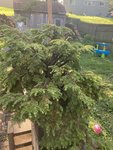
you can see the air-layer attempt of my collected hemlock sacrifice in the back. I hope to get another of it’s kind so that I can attempt some grafts in the future. Although the new branches are flexible enough, I suppose I don’t need another.

MrFancyPlants
Omono
River's Edge
Masterpiece
If you can, keep all the thin branches remaining off the trunk and main branches. Will be key to design the natural foliage flow downward on a shorter tree with broader base! Let us know how the grafting turns out, from your comments I gather you are going to try approach grafting rather than scion grafts.Did some minor cut (and grow) on this one today. It is hard to figure a master plan because the foliage is so dense, so I figure I work backwards branch by branch until I get a better idea of what is going on on the inside. No birds will be flying through, but it is progress. I’m leaving the lowest branches untouched since they will not be shading anything out, and it had a thorough repot from nursery stock, into the flat, early last spring. The leader had some dieback but is thoroughly intact. I am surprised there is no growth moving up however. It all seems to branch from the top section. I sure hope the apex regains some form of apical dominance.
you can see the air-layer attempt of my collected hemlock sacrifice in the back. I hope to get another of it’s kind so that I can attempt some grafts in the future. Although the new branches are flexible enough, I suppose I don’t need another.View attachment 317461
River's Edge
Masterpiece
I would reduce the lower branches in length and ensure the small apical branches are the highest branches to encourage this. The lower branches will not retain that length in the final design. This will also open up the interior more to keep the interior healthy and prevent excessive needle loss in the interior.I sure hope the apex regains some form of apical dominance.
MrFancyPlants
Omono
Yes, on this forum, but I forget from whom (@ABCarve?) I learned of an approach graft called a spot graft or one point graft, that sounded approachable enough for my limited manual dexterity. Something along the lines of drilling a small hole in the trunk or branch, and tucking a thin branch, sideways into the hole. I would love to hear more details on grafting with Hemlock from those who have experience. I know they have strong cambial healing capabilities.
River's Edge
Masterpiece
I would like to help you out, but I do not know of anyone who has grafted hemlock in my neck of the woods. I am aware of the one point graft method but have not tried it or seen the results on anyone else's work. It does sound promising in certain applications. Expect the tricky part is to secure the branch or pot in the right position to bend in the shoot.Yes, on this forum, but I forget from whom (@ABCarve?) I learned of an approach graft called a spot graft or one point graft, that sounded approachable enough for my limited manual dexterity. Something along the lines of drilling a small hole in the trunk or branch, and tucking a thin branch, sideways into the hole. I would love to hear more details on grafting with Hemlock from those who have experience. I know they have strong cambial healing capabilities.
ghues
Omono
This western gave a second flush this summer. I trimmed it by cutting back to smaller branchlets (as in Photos).
Photo 1- whole tree, upper pads completed, second photo, lower pad untrimmed, photo 3 upper pad trimmed, 4-5 show the same branch before and after.
Cheers
G
Photo 1- whole tree, upper pads completed, second photo, lower pad untrimmed, photo 3 upper pad trimmed, 4-5 show the same branch before and after.
Cheers
G
Attachments
-
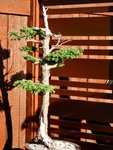 A458A83F-BA40-4DC3-88BE-7474FE654157.jpeg232.9 KB · Views: 68
A458A83F-BA40-4DC3-88BE-7474FE654157.jpeg232.9 KB · Views: 68 -
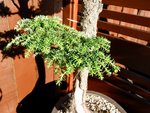 A5599625-AD5A-4C0F-948C-60790B052AB9.jpeg225.8 KB · Views: 53
A5599625-AD5A-4C0F-948C-60790B052AB9.jpeg225.8 KB · Views: 53 -
 76896935-592B-4634-8BBA-352453B26792.jpeg220.1 KB · Views: 38
76896935-592B-4634-8BBA-352453B26792.jpeg220.1 KB · Views: 38 -
 623C74A4-16C5-47A6-A044-AA53540EAB1D.jpeg177.9 KB · Views: 37
623C74A4-16C5-47A6-A044-AA53540EAB1D.jpeg177.9 KB · Views: 37 -
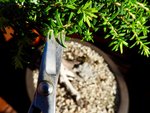 4AB1BA65-4BEE-493C-89AD-B973E84D04A6.jpeg156.1 KB · Views: 63
4AB1BA65-4BEE-493C-89AD-B973E84D04A6.jpeg156.1 KB · Views: 63
River's Edge
Masterpiece
This is a Mountain hemlock progression from May 2018 to May 2020. The pad formation was created using a layered branch structure. This is initially set by wiring and the foliage on primary branches is cut to roughly an elongated diamond form and then shaped as it grows into the wired form. I prefer a downward movement for hemlock designing the primary branches are wired downward to give a sweeping effect. The last picture displays the spring flush and is in need of thinning and trimming to define the pad shape further. It does illustrate the progress towards density and form possible with hemlock in a relatively short period of time. With this method the tree is allowed to grow without minor trimming to allow greater strength and thus a stronger response when pruned. For this portion of development fertilizer is not withheld or discontinued, but provided at all times during the growing season.

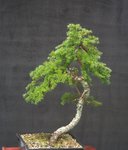
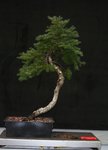
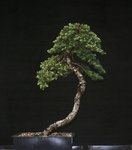




Japonicus
Masterpiece
@River's Edge that's beautiful Frank.
I am afraid of the ball in socket dislodging when bending the branches on the Canadensis I have
so I guess I'll have the arc on all my branches when they get wire.
I am afraid of the ball in socket dislodging when bending the branches on the Canadensis I have
so I guess I'll have the arc on all my branches when they get wire.
River's Edge
Masterpiece
Thanks, I find Hemlock require repetitive wiring to finally get major branches holding form. They have a strong tendency to bounce back. I have used #4 through #22 copper wire for Hemlock. Most of the tie down wire you see in the initial wiring simply holds the position, not the movement of the branches. Each branch is separately wired for movement. I use branch benders and bonsai jacks to get the strong change of position and then wiring to hold the position. Major wiring on thicker trunk or branch portions helps to distribute the pressure evenly and the raffia helps to protect the bark.@River's Edge that's beautiful Frank.
I am afraid of the ball in socket dislodging when bending the branches on the Canadensis I have
so I guess I'll have the arc on all my branches when they get wire.
Japonicus
Masterpiece
Thanks, I find Hemlock require repetitive wiring to finally get major branches holding form. They have a strong tendency to bounce back. I have used #4 through #22 copper wire for Hemlock. Most of the tie down wire you see in the initial wiring simply holds the position, not the movement of the branches. Each branch is separately wired for movement. I use branch benders and bonsai jacks to get the strong change of position and then wiring to hold the position. Major wiring on thicker trunk or branch portions helps to distribute the pressure evenly and the raffia helps to protect the bark.
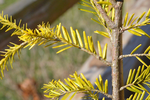
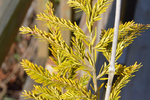
These are the "ball and sockets" I'm talking about.
You can find several that stand out, and they're quite easily snapped out of socket when bent
like it needs cut and grow directions with deciduous The v type near the top of 1st pic is the worst, impossible I say.
There's a ton of experience behind your words here, and I believe sooner than later would be best for wiring branches down initially?
River's Edge
Masterpiece
In the first picture I assume you are referring to the thicker branch. I would gauge it to be too thick in relation to the trunk and would either use it to create taper for a new apex or cut it off, choosing to develop and wire the smaller branches. I would not keep a V for a Hemlock design, so would remove a portion of the V to create further taper in that location.View attachment 326652 View attachment 326653
These are the "ball and sockets" I'm talking about.
You can find several that stand out, and they're quite easily snapped out of socket when bent
like it needs cut and grow directions with deciduous The v type near the top of 1st pic is the worst, impossible I say.
There's a ton of experience behind your words here, and I believe sooner than later would be best for wiring branches down initially?
The trunk appears thin using the bamboo stake as a measurement comparison. Which is in keeping with the bark formation at this time. So plenty of time to introduce movement to the trunk itself!
I would wire movement into the trunk, keeping in mind position of branches for outside curves and easier wiring for downward movement. Lots of growing to do, so keep all the foliage for now and put it in the ground or a large grow box for a few years. If transplanting or repotting I would wait for late winter/early spring.
It would be easier to give specific suggestions for the tree if the overall could be viewed. None of the branches, nor the trunk as it appears now would require branch benders or Bonsai jacks. Simply the proper size copper wire applied with care and anchored effectively.
ghues
Omono
Nice work Frank, I also appreciate the sweeping (weeping) styling, which IMHO portrays the natural habitat of this species. Next, a new pot?This is a Mountain hemlock progression from May 2018 to May 2020. The pad formation was created using a layered branch structure. This is initially set by wiring and the foliage on primary branches is cut to roughly an elongated diamond form and then shaped as it grows into the wired form. I prefer a downward movement for hemlock designing the primary branches are wired downward to give a sweeping effect. The last picture displays the spring flush and is in need of thinning and trimming to define the pad shape further. It does illustrate the progress towards density and form possible with hemlock in a relatively short period of time. With this method the tree is allowed to grow without minor trimming to allow greater strength and thus a stronger response when pruned. For this portion of development fertilizer is not withheld or discontinued, but provided at all times during the growing season.
View attachment 326602View attachment 326603View attachment 326604View attachment 326605
Similar threads
- Replies
- 1
- Views
- 180
- Replies
- 11
- Views
- 563
- Replies
- 3
- Views
- 554
- Replies
- 7
- Views
- 1K
- Replies
- 18
- Views
- 2K
